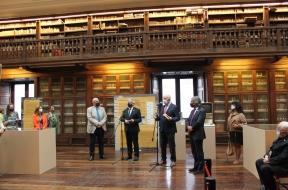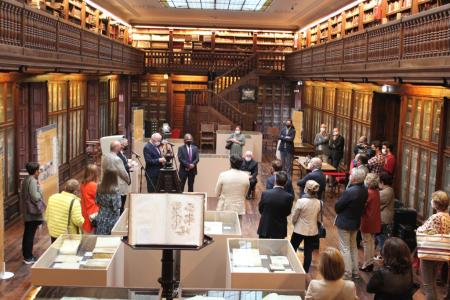Exhibition to commemorate the Library's 250th Anniversary
The exhibition gives us the opportunity to look at historical documents that reflect how the library has changed over the years as well as a selection of the bibliographic jewels that it contains.
Today, Thursday September, 24th, at 6.30pm, the university's rector, Santiago García Granda, is presiding over the opening of the exhibition "The University of Oviedo Library (1770-2020): 250 Years of Opening Doors to Knowledge", which you can visit in the general hall of the library itself (Historic Building, Oviedo). Dr García Granda will be accompanied by the Vice-Rector for University Extension and International Development, Francisco José Borge López; the Vice-Rector for Research, José Ramón Obeso; and the former university library director and director of the Royal Institute of Asturian Studies, Ramón Rodríguez Álvarez. Due to the ongoing Covid-19 situation, access to this event will be restricted.
The exhibition, curated by Ramón Rodríguez Álvarez himself and by María José Ferrer Echávarri, university librarian, offers an overview of the history of the library and its valuable collections. It allows us to view historical documents – books, videos, photographs and other items – that reflect the library's evolution since 1770, as well as a selection of the bibliographic jewels it houses. The visitor journey takes you through the following periods: "The Primitive University Library (1608-1765)", "The Creation of the University Library and its First Steps (1765-1800)", "The University Library in the 19th Century", "From the University's Third Centenary to Destruction (1908-1934)" and "Reconstruction of the University Library (1934-1945).
As Rector Santiago García Granda explains in the exhibition catalogue: "When the University of Oviedo started back in 1608, its library occupied a modest space between the walls of the Historical Building. In 1765, thanks to money from Asturian brigadier Lorenzo Solís, Manuel Reguera González from Candás designed a new floor to house a library which opened to the public in 1770. García Granda also recalls that "it was one of Charles III's ministers, Campomanes, who made the greatest effort to provide the university with a rich and modern library. Solís legacy was joined by contributions from the principality's general assembly and the university itself. The subsequent vicissitudes, especially after the War of Independence, meant that it lost the splendour it had regained in the last quarter of the 19th century with the birth of the magnificent special faculty of law library and a People's Section in 1918".
The "dramatic" turning point came with the destruction of the library and the university's historic building during the fire of 1934. There then followed a period of reconstruction, recovery and settlement, "largely driven by the Association of Former Students and Friends of the University of Oviedo", followed by a period of expansion that gave way to another drive by the "leadership of the Asturian University Library at the forefront of inter-library cooperation".
In 1989, under the supervision of Ramón Rodríguez, RUEDO was created – a network that brings together all the university libraries that use the DOBIS/LIBIS software. That year, the REBIUN university library network was also set up.
The rector believes "both the main central library and each of the libraries that are today located in our faculties or schools are temples of study, spaces for collaborating and generating ideas and projects".
The exhibition will be open to the public from Friday until November, 18th in the chapel and library of the Historic Building. Opening times: Monday to Friday, 11am to 2pm and 5pm to 8pm; Saturday, 11am to 2pm and 5pm to 7pm, and on Sundays and public holidays from 11am to 2pm.
Promotional video for the exhibition to commemorate the Library's 250th Anniversary:
The exhibition gives us the opportunity to look at historical documents that reflect how the library has changed over the years as well as a selection of the bibliographic jewels that it contains.
Infographic portraying the history of the Library
Images gallery
Documents
Links





